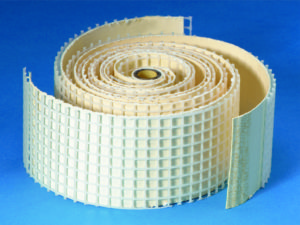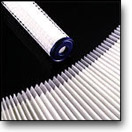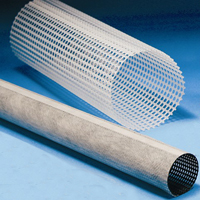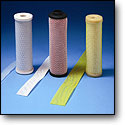Role of Plastic Netting
The role of plastic netting in the filtration industry is not singular. The wide variety of filtration and separation systems and media results in a wide range of uses and functions for plastic netting. The major functions of plastic netting in filtration can broadly be categorized as 1). Facilitating the flow of fluids, 2). Supporting, 3). Protecting, 4). Reinforcing, and 5) Filtering.
A major role for plastic netting in the filtration industry is to facilitate the flow of fluids, typically, through the filter element. A number of filter element configurations require a liquid stream to flow through layers of filter media, and plastic netting can serve as a spacer between such layers, allowing the fluid to be channeled across the filter medium.
The largest application for this “flow channel” function is with spiral filter elements. In this application the plastic netting, usually bi-planar diamond netting, serves as a “feed spacer” allowing the liquid stream to flow across the membrane surface.
Plastic netting is more likely to support another substrate which functions as the filter medium,  whether that substrate is a woven, non-woven or membrane-based material. As extruded plastic netting is more rigid than a woven or non-woven material, it can provide support to the medium in helping it retain a given shape or support the material against the liquid or air stream. One major application for plastic netting is as a pleat support material in pleated cartridge filters. The pleat pack must be supported, with relatively uniform separation between the pleats. Plastic netting provides enough rigidity to keep all of the pleats uniformly exposed to the stream, thereby improving the filters’ efficiency.
whether that substrate is a woven, non-woven or membrane-based material. As extruded plastic netting is more rigid than a woven or non-woven material, it can provide support to the medium in helping it retain a given shape or support the material against the liquid or air stream. One major application for plastic netting is as a pleat support material in pleated cartridge filters. The pleat pack must be supported, with relatively uniform separation between the pleats. Plastic netting provides enough rigidity to keep all of the pleats uniformly exposed to the stream, thereby improving the filters’ efficiency.
Diamond netting, because of its bi-planar joint construction, and square netting, because of its higher profile strand construction, can provide support for the medium with minimal contact against the substrate, to reduce the effects of blinding. In some filters, the support netting serves to protect the medium from handling as well.
Plastic netting also serves a support function when used as a rigid tube for center cores in cartridge filtration. In this application, flow characteristics are also important, but the primary role of the netting in this application is structural support.
Plastic netting serves as support in other ways beyond pleated cartridges. Panel filters in air filtration will often include a plastic netting screen to add support to the filter medium contained within the structural frame.
Plastic netting is also used to protect the filter medium from damage during us e and handling. Rigid tubes, described earlier as structural support center cores, are also used as outer sleeves to protect the filter element. Lighter weight, flexible tubular “sleeve” material is also used in this application, where different colors are often used to identify specific filters. Plastic netting may also be used as a screen in a number of filter element configurations to prevent damage from handling, such as in a panel filter.
e and handling. Rigid tubes, described earlier as structural support center cores, are also used as outer sleeves to protect the filter element. Lighter weight, flexible tubular “sleeve” material is also used in this application, where different colors are often used to identify specific filters. Plastic netting may also be used as a screen in a number of filter element configurations to prevent damage from handling, such as in a panel filter.
Another role for plastic netting is to reinforce another substrate. Often times the netting is incorporated in a non-woven, for example, to provide improved performance characteristics to that substrate, such as strength, tear resistance, etc. When the netting is incorporated into another substrate, by means of lamination, needle-punching, etc., it is part of the composite medium, improving the performance attributes of that medium, and does not have a separate function in the filter element.
At first exposure to the industry and plastic netting, one might think plastic netting functions as a filter medium. But in fact, plastic netting is least used a filter medium itself, unlike similar-looking woven materials, which are commonly used as a filter medium. In cases where extruded netting is used as a filter screen, the applications generally involve very crude filtration, either large particles or even debris.
Across the many filtration applications for plastic netting, the primary product or performance attributes desired can be described as thickness, rigidity, or flow.
In some applications, plastic netting is required to fill a certain volume; a spacing between layers of substrates, for example. In such applications, the products’ thickness is of primary concern. In other applications, the rigidity of the product is important, as it helps support the medium or the filter element itself. In other applications, the flow rate is of primary concern. In such applications the hole size may be important or the depth of the flow channel along the strands.
In spite of the many applications for plastic netting in filtration, the essential qualities that are required relate to the products’ thickness and the hole size. Beyond that, more subtle attributes such as strand height or shape, are manipulated to optimize filtration performance in a given application.
Outlook
Many of the uses for extruded plastic netting are derived from woven applications, where extruded products displaced woven materials because of a cost advantage. Plastic netting is also advantageous because of its welded joint and non-fraying characteristics. By expanding the process capabilities to cover a wider range of products, extruded plastic netting manufacturers can offer the industry a wider choice of materials.
Plastic netting has mostly been available in polypropylene and polyethylene; with mesh counts typically lower than woven materials. It has only been recently that products have become available in other resins, while synthetic woven producers have been able to provide materials in a broader range of materials for years. Development efforts by producers have resulted in a further expansion of the product line into higher mesh count products and resins, which will contribute to further growth of this industry.

Leave a Reply